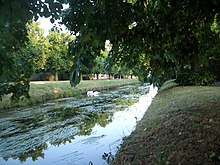Duke of Northumberland's River
51°28′14″N 0°19′19″W / 51.47056°N 0.32194°W

The Duke of Northumberland's River or D. O. N. River consists of separate upper and lower
Western section

The western section was constructed during the reign of King
In 1530, a record lists an increase, probably temporary, of 42 labourers working on a new river cut from Longford (probably the Duke of Northumberland's River).[3]
This section diverts a small proportion of water from the
The river is carved[clarification needed] east to join the Crane in patchy woodland known as Donkey Wood, by Baber Bridge at the west end of Hounslow Heath. 51°27′35″N 0°24′08″W / 51.4596°N 0.4022°W
Eastern section
This section diverts water from the Crane in Kneller Gardens,
This part is the older — it was built in the time of Syon Abbey, over 100 years before it was inherited, in 1594, by wife of the "wizard earl", Henry Percy, 9th Earl of Northumberland, Dorothy (née Devereux) which automatically became his own as this inheritance preceded the Married Women's Property Act 1870.
The Duke of Northumberland's River can thus be described as a distributary of the Colne and a tributary of the Crane; it is also a distributary of the Crane and a tributary of the Thames. 51°27′21″N 0°20′39″W / 51.45583°N 0.34417°W
It seems that the Crane was little more effective than the Bourne [inchoate, natural final part of the Duke of Northumberland's River] in driving a mill, for the new mill between Isleworth and Twickenham is not referred to again, and by 1543 yet another mill (later known as the Isleworth Manor Mill or Kidd's Mill) was being built at the old position near the mouth of the Bourne, while the Bourne was reinforced by a new river specially built across Hounslow Heath from the Colne. (fn. 15) The new mill remained an appurtenance of Isleworth manor until 1876. (fn. 16) It had two mill-stones in 1553, (fn. 17) and five in 1633, of which four ground corn and the fifth ground wood for dyes. It had only the four corn-grinding wheels in 1669, when it was to be rebuilt by the lessee. (fn. 18) By 1845 there were two steam-engines to assist the water-power and the mill was said to be one of the largest for flour in England. (fn. 19) The lessee was then Richard Kidd. After some variations in the firm's name, Samuel Kidd & Co. Ltd. were the owners when the mill stopped work a little while before it was demolished in 1941.
— Susan Reynolds, 1962[7]
See also
- Tributaries of the River Thames
- List of rivers in England
Notes
- ^ The abolition of copyhold by the Law of Property Act 1925 meant the de facto abolition of pecuniary manorial rights
References
Citations
- ^ 'Twickenham: Introduction', in A History of the County of Middlesex: Volume 3, editor: Susan Reynolds (London, 1962), p. 139. British History Online http://www.british-history.ac.uk/vch/middx/vol3/pp139-147. Accessed 18 August 2017.
- ^ "Heston and Islesworth: Manors". British History Online.
- ^ "Harmondsworth: Introduction - British History Online". www.british-history.ac.uk.
- ^ "Explore georeferenced maps - Map images - National Library of Scotland".
- ^ Sherwood 2006, p.11
- ^ Sherwood 2006, p.10
- ^ 'Heston and Isleworth: Mills', in A History of the County of Middlesex: Volume 3 ed. Susan Reynolds (London, 1962), pp. 112-114. British History Online http://www.british-history.ac.uk/vch/middx/vol3/pp112-114
Bibliography
- Sherwood, Philip. (2006) Around Heathrow Past & Present. Stroud: Sutton Publishing ISBN 0-7509-4135-9
External links
- Longford Residents Association article on the river Archived 27 June 2006 at the Wayback Machine
